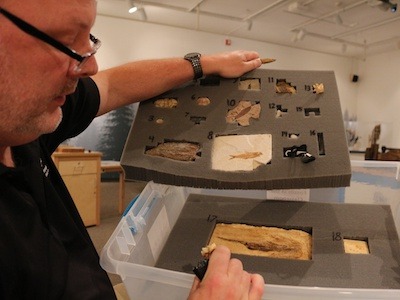
Museum educator Jim Hakala describes a clam shell fossil to University Hill Elementary School students in Boulder. (Photo by Sue Postema Scheeres, CU Boulder)

Hakala with kit containing real and cast fossils that he delivers to classrooms across Colorado. (Photo by Sue Postema Scheeres, CU Boulder)
Nov. 26, 2018 • By Sue Postema Scheeres
If Jim Hakala had his way, every fourth-grader in Colorado would be able to hold a piece of ancient history.
The senior educator at the CU Museum of Natural History is more than halfway to this goal, bringing museum resources like fossils and ancient artifacts to hundreds of schools in 41 Colorado counties.
It’s a labor of love that began in 2010, when Hakala worked with paleontologists, collection managers and local teachers to create a “unit in a box” filled with fossilized cave bear and shark teeth, dinosaur bone, petrified wood and other real and cast fossils as well as lessons that align with Colorado academic standards. The outreach program soon expanded to include other kits focused on archaeology and mammals.
“It just seemed like a no-brainer to me to bring these resources to communities that were looking for ways to teach about fossils and Colorado’s natural history and didn’t have access to high-quality, hands-on science materials,” explained Hakala, who has worked at the museum for nearly 20 years. “We are the University of Colorado and through the museum’s exhibits and programs should be serving the state of Colorado.”
Hands-on connection to the past
Word about the free program spread quickly, with teachers sharing the fossil kits with other educators in their school, district and region.
To date, Hakala has personally delivered free fossil kits and teacher training to about 450 schools in 77 school districts, which are being used by more than 32,000 fourth-graders and 4,000 seventh-graders. The program is funded through the Office for Outreach and Engagement and the museum.
Myra Hanson, who has taught in eastern Colorado since 2014, said she stared at Hakala in disbelief when he delivered the first kit four years ago.
“I said ‘This is free? And we get to keep it?’ I was just overwhelmed that this was a free gift for my class,” she said. “There aren’t a lot of educational resources available to us on the eastern plains.”
Hanson said the kits have brought fossils to life for her students who, like all fourth-graders in Colorado, are required to learn about fossils as part of the state science standards.
“It really transformed my teaching,” said Hanson, who now teaches at Wiggins Elementary School in Wiggins, Colorado. “I don’t have to describe the fossils or show a video. The kids can see for themselves the difference between the fossils, they can feel the edges of the fossils and something that is thousands or millions of years old has real meaning for them.”
Expanding to other areas of natural history
The success of the fossil kits prompted the museum to expand its outreach program, creating free archaeology kits with ancient historical artifacts for schools to keep and discovery kits about a range of natural history topics that can be rented. The museum is currently developing mammal kits filled with skins, skulls and other specimens.
Hannah Squire, a fourth-grade teacher at Animas Valley Elementary School in Durango, Colorado, said the archaeology kits have helped her students better understand Ancestral Puebloans, Fremont People and other early Coloradans.
“During our annual living history wax museum, students incorporated realistic props and actions, based on what they had discovered about hunting,” Squire said. “I am incredibly grateful these resources became available.”
These stories motivate Hakala to continue pursuing his dream of putting the materials in the hands of every fourth-grader in Colorado.
“I love what I am doing,” Hakala said. “I like that I can make these connections, and that a fourth-grader can go ‘Wow, I understand this!’”
Learn more about how to obtain outreach kits for your school!

Hakala with kit containing real and cast fossils that he delivers to classrooms across Colorado. (Photo by Sue Postema Scheeres, CU Boulder)